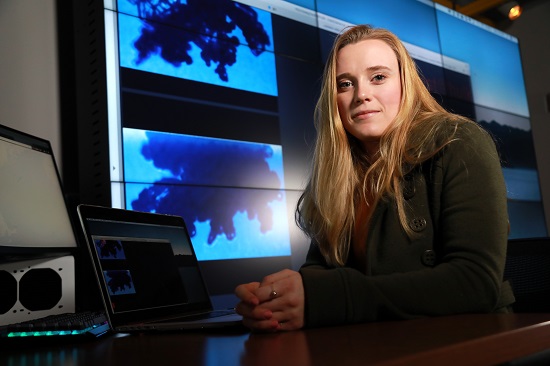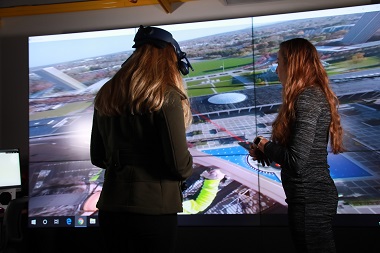U.S. Department of Energy Turns to ASRC for New Cloud Imagery Database
 |
|
Graduate student Vanessa Przybylo uses a machine learning model to sift through cloud particle images in the xCITE Lab. (Photo by Patrick Dodson) |
ALBANY, N.Y. (Oct. 29, 2020) – For decades, the U.S. Department of Energy (DOE) has collected millions of digital cloud particle images from under the wing of research aircrafts used during observational field campaigns.
Kara Sulia is now leading a team of scientists to make sense of this massive dataset.
DOE's Office of Science recently announced $19 million in funding for 31 new projects that are aimed at improving the power of Earth system models to predict weather and climate, including support for a new database tool that will consolidate and characterize all of its cloud particle imagery.
“A cloud particle imager probe is onboard most, if not all, aircrafts deployed during DOE-supported field campaigns,” said Sulia, a research associate at UAlbany’s Atmospheric Sciences Research Center (ASRC). “The probe can capture thousands of individual images during any given campaign. However, the data has yet to be organized or exploited in a useful way, and given the large numbers, it is the perfect dataset for machine learning and data processing.”
Classifying Clouds
 |
|
Sulia (right) and Przybylo use a VR headset in the xCITE lab to explore views from the top of the Carillion on the Uptown Campus. (Photo by Patrick Dodson)
|
DOE is supporting the database development with $599,204 in funding over the next three years. Sulia’s research team, including Department of Atmospheric and Environmental Sciences graduate student Vanessa Przybylo, has already developed a beta version that is now going through an extensive testing phase.
Once launched, each image in the database will include a characterized list of information such as the date it was taken, the altitude, latitude/longitude, and environmental characteristics such as air temperature. Machine learning technologies are used to classify the particle by type, and other AI techniques will be used to extract particle properties, such as its shape and size.
“Every ice particle has a unique growth history,” Sulia said. “Our classification will help better profile the microphysical, thermodynamic, and dynamic processes that may have been happening within the cloud when the image was captured. This not only helps to understand the observed weather and climate conditions, but also to identify any shortcomings in simulations we run of a specific weather event that was happening at that time.”
DOE researchers will be able to interact with the database through a user-friendly web-based interface. It will first launch with existing imagery datasets, but new data from future field campaigns can be easily added.
UAlbany’s xCITE lab, which Sulia directs, is providing technical support and training. The project is also incorporating research findings from Przybylo’s PhD dissertation. She graduates next semester and is planning to transition to a postdoctoral position on the project.
“This database concept in itself is entirely new. But, the classification scheme we are proposing in this work is unique and novel and utilizes the most recent and advanced hardware/software tools available today,” Pryzbylo said. “We believe the accuracy of our scheme will exceed those who have attempted before us to develop methodologies that classify CPI imagery.”
Other collaborators include Zachary Lebo of the University of Wyoming and Carl Schmitt of the University of Alaska, Fairbanks.
![]() For more news, subscribe to UAlbany's RSS headline feeds
For more news, subscribe to UAlbany's RSS headline feeds
A comprehensive public research university, the University at Albany-SUNY offers more than 120 undergraduate majors and minors and 125 master's, doctoral and graduate certificate programs. UAlbany is a leader among all New York State colleges and universities in such diverse fields as atmospheric and environmental sciences, business, education, public health,health sciences, criminal justice, emergency preparedness, engineering and applied sciences, informatics, public administration, social welfare and sociology, taught by an extensive roster of faculty experts. It also offers expanded academic and research opportunities for students through an affiliation with Albany Law School. With a curriculum enhanced by 600 study-abroad opportunities, UAlbany launches great careers.


